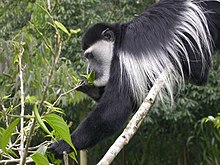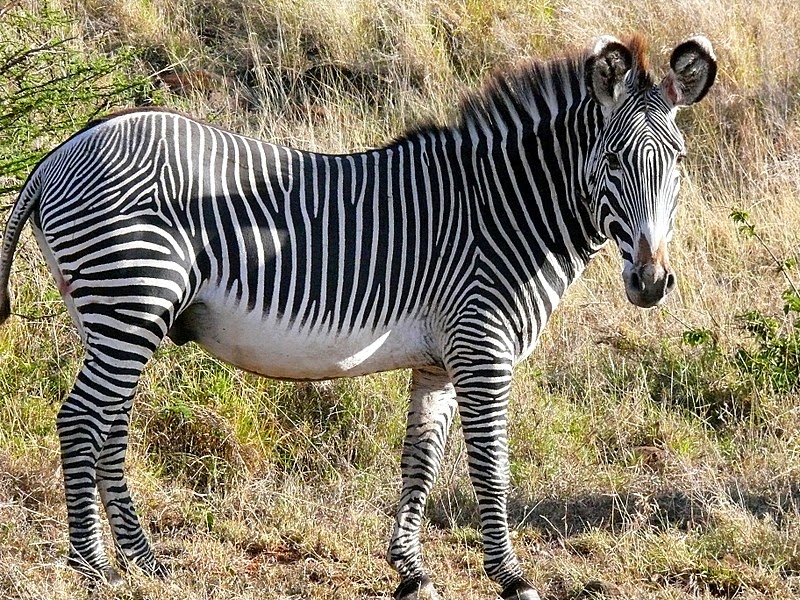The mantled guereza is diurnal and arboreal, found in both deciduous and evergreen forests. It is an adaptable species that can cope with habitat disturbance and prefers secondary forest close to rivers or lakes. Although previously thought only to eat leaves, it also eats seeds, fruits, and arthropods. It is able to digest plant material with a high fibre content with its specialised stomach and may only eat from a few plant species at a time. It is preyed on by birds of prey and some mammals, such as the common chimpanzee and the leopard.
The mantled guereza lives in social groups of three to fifteen individuals. These groups normally include a dominant male, several females, and the offspring of the females. It has a polygynous mating system and copulation is initiated with vocal communication. After a gestation period of just over five months, infants are born with pink skin and white fur, which darkens to the adult coloration by three to four months. The mantled guereza is well known for its dawn chorus, the males' "roar" is a method of long distance communication that reinforces territorial boundaries. It also makes other vocalization and uses body postures, movements, and facial expressions to communicate.
The mantled guereza is listed as Least Concern by the International Union for Conservation of Nature (IUCN) because it is widespread - although it is locally threatened in some areas, the decline is not great enough to list it in a higher category of threat. However, one subspecies found in Kenya is listed as Endangered. It can survive well in degraded forests and in some areas it is more common in logged areas than unlogged ones. The mantled guereza is also threatened by hunting for bushmeat and for its skin.

Etymology

The mantled guereza has many alternative common names including the guereza, the eastern black-and-white colobus, the magistrate colobus,[2] or the Abyssinian black-and-white colobus.[3] The name "mantled" refers to its mantle, the long silky white fringes of hair that run along its body and "guereza" is the native name of the monkey in Ethiopia.[4] The scientific name Colobus derives from Greek kolobus meaning "mutilated" which refers to its lack of thumbs.[5]
Discovery and taxonomic classification
The mantled guereza was discovered by Eduard Rüppell, a German naturalist and explorer, during his trip to Abyssinia between 1830 and 1834.[6] He wrote about the species in Neue Wirbelthiere con Abyssinien, Saengthiere in 1835.[7] It was first seen in Europe in 1890 in Berlin Zoological Garden when three individuals were purchased from a dealer from Massawa, Eritrea.[8]
The mantled guereza is in the Colobinae subfamily, also known as the leaf-eating monkeys, a group of Old World monkeys from Asia and Africa. This subfamily is split into three groups, the colobus monkeys of Africa, of which the mantled guereza is a part, the langurs, or leaf monkeys, of Asia, and an "odd-nosed" group. The African colobus monkeys are divided again by distinctions in color, behavior, and ecology. The three genera are the black-and-white colobi, the red colobi, and the olive colobi. There are three black-and-white colobi: the mantled guereza, Colobus guereza, the king colobus, C. polykomos, and the Angola colobus, C. angolensis.[9] Groves lists seven subspecies of mantled guereza in Mammal Species of the World (MSW) (2005).[1] The validity of the Djaffa Mountain guereza, C. g. gallarum, is uncertain, although not listed by Groves in MSW, it is recognised in his 2007 Colobinae review paper,[10] and by International Union for Conservation of Nature (IUCN) assessors Gippolliti and Butynski in 2008.[2]
- Western guereza, Colobus guereza occidentalis, occurs from eastern Nigeria, Cameroon, and Gabon at the edge of its western range to South Sudan and Uganda, west of the Nile.
- Omo River guereza, C. g. guereza, found in Ethiopia, in the highlands west of the Rift Valley down to the reaches of the Awash River, the Omo River, and in the Blue Nile gorge.
- Djaffa Mountains guereza or Neumann's black-and-white colobus, C. g. gallarum, found in the Ethiopian Highlands east of the Rift Valley.
- Dodinga Hills guereza, C. g. dodingae, found in the Didinga Hills in South Sudan.
- Mau Forest guereza, C. g. matschiei, occurs from western Kenya and Uganda south into northern Tanzania.
- Mt Uaraguess guereza or Percival's black-and-white colobus, C. g. percivali, found in the Matthews Range in Kenya.
- Eastern black-and-white colobus, C. g. kikuyuensis, occurs in Kenya on the Ngong Escarpment of Mount Kenya and in the Aberdare Range.
- Kilimanjaro guereza, C. g. caudatus, found in Tanzania and Kenya in the forests surrounding Mount Kilimanjaro and Mount Meru.
Physical description
Mantled guereza portrait showing its facial features
Infants are born with pink skin and white hair. The hair and skin darken as they age and by three to four months they attain adult coloration. Male usually gain their coloration before females.[12] The male typically weighs 9.3 and 13.5 kilograms (21 and 30 lb) and the female weighs between 7.8 and 9.2 kilograms (17 and 20 lb). The head and body length averages 61.5 centimetres (24.2 in) for males and 57.6 centimetres (22.7 in) for females. Like most colobi, the mantled guereza has a small thumb that is vestigial.[13][14] There is dentition sexual dimorphism among the subspecies. In some, the males have larger teeth than females, in others the reverse is true, and some have no significant difference.[15]
Distribution and habitat
Mantled guerezas are arboreal and prefer secondary forests.
Ecology
The mantled guereza is primarily arboreal, but does sometimes descend on the ground to forage and travel, perhaps more so than most other colobines. It is diurnal and rests for up to half the day. Foraging or travelling are the next most common activity. Sometime after dawn, mantled guereza groups leave their sleeping trees and will return to them at dusk. During the day, the mantled guereza has long rest periods in between periods of moving and feeding.[20][21][22] Other activities, including grooming, greeting, playing and being vigilant, are performed to a lesser extent.[21][22]
The diet of the mantled guereza is predominantly leaves, often of only a few tree species.
Like all colobi, the mantled guereza is able to digest leaves and other plant fibers with a large, multi-chambered stomach that contains bacteria in certain areas.[25] Like most colobines, it prefers foods with high fiber content that can be easily extracted with its specialized stomach.[24] The mantled guereza is mostly preyed on by the crowned hawk-eagle,[26] but it is also eaten by other birds of prey such as Verreaux's eagle.[17] The common chimpanzee is known to hunt the guereza.[27] The leopard is another possible predator.[28]
Behaviour
Social structure
Social grooming or allogrooming mainly occurs between females and is an important social interaction in mantled guereza groups.
Because of its low quality diet and the dispersed distribution of its food, the mantled guereza has a resident-egalitarian social structure. Female guerezas living in a group often have an egalitarian dominance style with no formalized rank relations. Relationships are relaxed and friendly with rare signals of dominance or subordinance. Physical aggression within the group is usually not harmful and rarely escalates into a conflict. Allogrooming is an important part of mantled guereza interactions and mostly occurs between females.[31] The adult males rarely groom in the groups. While not strictly territorial, mantled guereza groups can be aggressive towards each other.[21] In some populations, groups may defend core areas (which exist as a small part of the home range), resources, and mates. During intergroup encounters, males can engage in direct or indirect mate defense, like defending a female's resources.[32] It is the males that participate in agonistic inter-group encounters but female may do so as well.[21] Aggressive encounters between groups usually involve chases, displays and vocalizations rather than physical contact.[21]
Reproduction and parenting
Infants are born with white fur and are always carried during the first months of their life.
Communication
The most notable vocalization of the mantled guereza is the "roar", which is made mainly at night or dawn by males. The sound of a roar can be carried for up to a mile. It is normally the dominant male who roars when there are multiple males in the group. Roars are used for long distance communication and can regulate inter-group spacing without direct, physical contact while foraging.[38] When one male starts roaring, neighboring males will start to roar as well.[35] Often, the mantled guereza will respond to calls regardless of "caller identity," focusing more on the collective vocal displays and not the familiarity of the caller.[38] There is variation in the roars of males which could signal the status of their group and fighting ability.[35] With a roar, a male can advertise his body size; both actual and exaggerated.[39] Other vocalizations are made as well. Males may snort, possibly as an alarm call. "Purrs" are made before group movements. Females and infants may "caw" when under mild distress. When in more serious distress, like if an infant is in danger, females and sub-adults will squeak or scream. "Tongue-clicking" is made during mild aggression.[40] In addition to vocalizations, the mantled guereza communicates with several different body postures and movements, displaying of fringe fur, facial expressions, and touches.[37]Conservation status
Because it can live in both dry and gallery forests and move on the ground, the mantled guereza is less threatened than many other colobine species.[14] The IUCN lists it as Least Concern because "although locally threatened in parts of its range, this widespread species is not thought to be declining fast enough to place it in a higher category of threat."[2] However, some of the subspecies are classified under different categories. The Mt Uaraguess guereza, C. g. percivali, is listed as Endangered due to its small range and its risk from hunting,[41] while the Dodinga Hills guereza, C. g. dodingae, the Djaffa Mountains guereza, C. g. gallarum, and the Mau Forest guereza, C. g. matschiei are all listed as Data Deficient.[42][43][44]
The Dodinga Hills guereza hasn't been recorded since the 1960s.[42] Unlike most other primate species, the mantled guereza can survive habitat degradation and can even thrive in degraded forests.[45] Sometimes, logging may increase the number of preferred food trees for the mantled guereza and it is more abundant in logged areas than unlogged ones.[14] However, complete forest clearance causes dramatic declines in numbers. In Uganda complete forest clearings caused a decline of 50% over eight years.[46] The mantled guereza is also threatened by hunting for meat and its skin. Mantled guereza meat sells as bushmeat for $4–9 US.[47] The skins have been sold for fashion or in the tourist trade.[48]







No comments:
Post a Comment
Note: Only a member of this blog may post a comment.